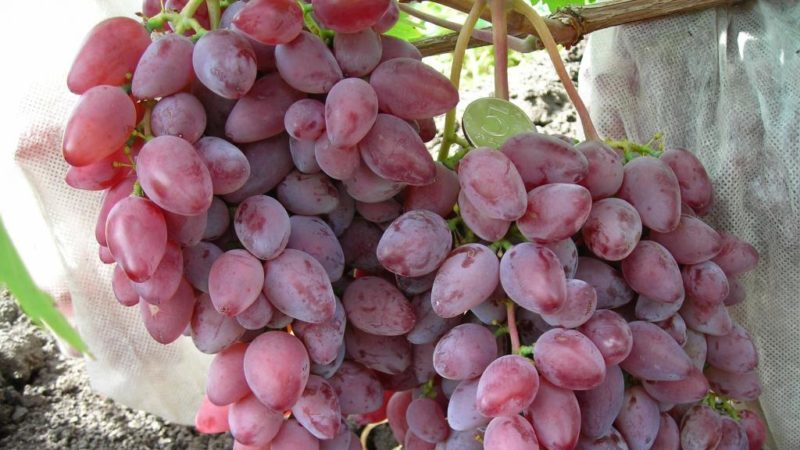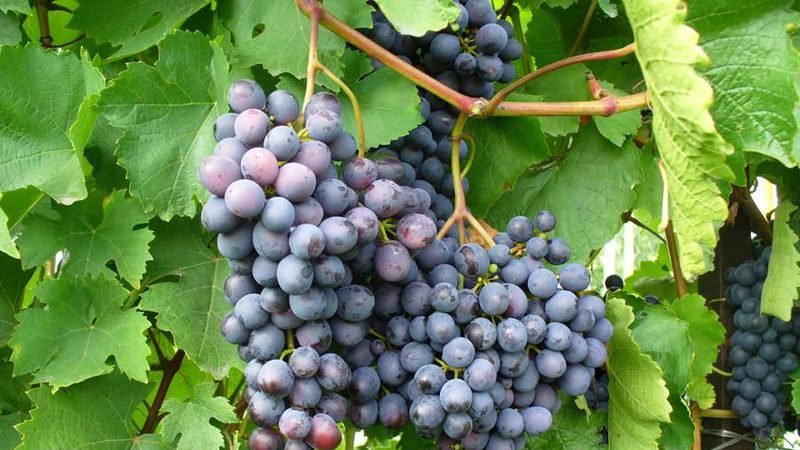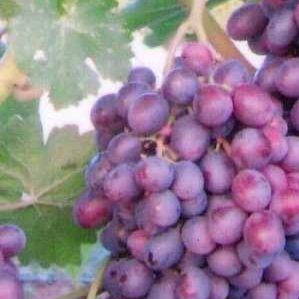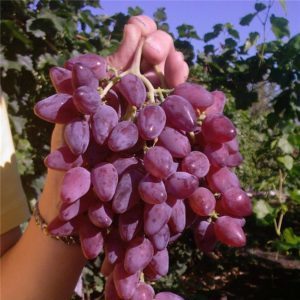Frost-resistant high-yielding hybrid of grapes "Amethyst"
Amethyst grape is a group of hybrids Samara, Novocherkassky and Sredne early Amethyst, collected under a common name. Cultures are distinctive because they have different ancestors. They are united in one group: high yield, a small amount of soft and edible seeds, resistance to gray rot, mildew and oidium, rich dark pink or purple color of berries.
The content of the article
Description and history of origin of the Amethyst grape hybrid

The name of the grapes Amethyst or Amethyst is common to three hybrids from different "parents". In the course of breeding work, the engineers managed to obtain the best qualities.
Hybrid Novocherkassk Amethyst was bred by crossing the Red and Delight varieties. The selection was carried out by employees of the Novocherkassk VNIIViV them. A.I. Potapenko (Rostov region) in 2009.
Samara Amethyst obtained on the basis of Muscat Hamburg and Early Ripe Kuibyshev. The breeding work was carried out by V. Paltseva, P. Merkulova, N. Kazakova at the Kuibyshev zonal experimental gardening station. On trial in 1986.
Super Early Amethyst - a new hybrid bred by crossing the varieties Tavria and Antey Magarachsky. The authorship belongs to the object P.Ya. Golodriga. Distinctive features have not yet been thoroughly studied, therefore, reliable information about him has not been presented. It is only known that it is a hybrid of early ripening, soft-seeded, dessert purpose. It is characterized by high resistance to mildew and powdery mildew, gray rot and frost down to -28 ° C.

Characteristics of hybrids
Hybrids Novocherkasskiy and Samarskiy Amethyst received signs of different parents, so each of them has its own characteristics. Distinctive features are presented in the table.
| Indicators | Novocherkassk | Samara |
| Ripening period | 90-110 days | 105-115 days |
| The power of growth | Above the average | Above the average |
| Escapes | Long, brown | Long, brown |
| Leaves | Wrinkled, slightly curved, green in color, rounded, three- and five-lobed, with a weak edge | Wrinkled, slightly curved, green in color, rounded, three- and five-lobed, with a weak edge |
| The beginning of flowering | I-II decade of June | I-II decade of June |
| Flowers | Bisexual, do not need pollination | Bisexual, do not need pollination |
| The beginning of fruiting | 3 years after landing | 3 years after planting |
| Brush shape | Cylindrical | Cylindrical |
| Weight | 300-800 g | 170-270 g |
| Berry shape | Oval, elongated | Oval, elongated |
| Color of berries | Dark pink | Dark pink with a purple tint |
| Berry mass | 6-8 g | 6-8 g |
| Skin | Thin | Thin |
| Peeling | Not inclined | Not inclined |
| Pulp | Juicy, meaty, crispy | Juicy, meaty, crispy |
| Bones | 1-2 pcs., Soft | 1-2 pieces, soft |
| Taste | Balanced, with a plum flavor | Simple, pleasant, sweet with sourness |
| Tasting assessment | 8.3 points | 8.1 points |
| Sugar content | 16-23% | 12-15% |
| Acidity | 0,5-0,7% | 0,5-0,8% |
| Yield | 10-12 kg per bush | 10-12 kg per bush |
| Frost resistance | -33 ... -35 ° C | -25 ° C |
| Harvesting | Late August-early September | Late August-early September |
| Appointment | Canteen, technical | Canteen, technical |
Hybrid Amethyst Novocherkassky is able to recover from dormant buds in spring even after severe freezing. This feature allows it to be grown in regions with cold climates as a non-sheltering crop.Amethyst Samara needs preparation for winter and hideouts.
The Novocherkassk hybrid is suitable for cultivation in the central, southern, northwestern regions of Russia, the Far East and Siberia. Amethyst Samara and Super early are cultivated mainly in the central part of Russia (Moscow region), in the south and in the Volga region.
Planting seedlings
Planting of Amethystovy grape hybrids is carried out mainly with seedlings in a sunny area, with a low groundwater table. Soil type - clayey, sandy loam or black soil.
Seedlings are purchased from specialized nurseries and carefully examined for damage to the root system and traces of rot. The roots should be light and healthy in appearance.
Planting is carried out in the spring, the seedlings are placed at a distance of 2 m from each other. In the selected area, a hole is dug 80x80 cm on clay soil and black earth, 80x80x105 cm - on sandy loam.
Crushed stone or broken brick is placed on the bottom, a layer of fertile soil mixed with 500 g of azophoska, 500 g of ash and 10 liters of humus is poured on top, then a layer of clean earth, and watered abundantly. After 3 weeks, after the soil subsides, a hole 50-55 cm deep is formed and a seedling is planted in it, the roots are straightened, covered with soil and watered abundantly.
A wooden support is dug in next to the seedling, and it is shaded with cardboard from the south side. A week later shelter remove and spud the seedling. During this time, new shoots will form.
Interesting. During archaeological excavations in Georgia, they found a jug with painted clusters, created about 8 thousand years ago, and seeds of wild grapes, whose age is 60 million years.
Subtleties of care
Amethyst grapes are unpretentious in care and need moderate watering, loosening the soil and removing weeds, adding nutrients and pruning... Agricultural technology is the same for the Samara and Novocherkassky hybrid.
At the initial stage of seedling development, weeding is carried out regularly, since the greenery draws nutrients from the soil.
After the appearance of foliage, the soil around the seedlings is broken up and 10 cm of surface roots are removed to strengthen the root system. The procedure is carried out twice - in June and August.
In June, pruning is carried out - out of 3-4 shoots, 1-2 of the strongest are left, the rest are removed. In the fall, 80% of the branches that appeared in the summer are removed, at the same time as those that have matured, are sick, damaged and weak.
Novocherkassk Amethyst needs to be pruned by 4-6 eyes. The optimal load is 30-35 eyes per bush.
The frequency of watering young seedlings depends on the availability of mulch under the crown. Mulching allows you to reduce the number of watering to 1 time in 2 weeks, and retain moisture in the soil. Without mulch, planting is watered weekly. 10 liters of water are poured under 1 bush. Simultaneously with watering, fertilizing with nitrogen and superphosphate is performed.
In autumn, watering the Novocherkassky hybrid is stopped, and the plant is given the opportunity to independently prepare for wintering.
The situation is quite different with Amethyst of Samara. The plant needs preparation and shelter for the winter. In autumn, after harvesting, the water consumption is increased to 60 liters per bush. Pruning is performed 2 weeks after leaf fall.
With the arrival of the first frost, the plant is covered with agrofibre, dense polyethylene, spruce branches, leaving a gap for air circulation, and preventing the bushes from rotting.
Adult plants are watered according to the following scheme:
- in early spring, before the buds swell;
- in May, before flowering and after the formation of ovaries;
- in July, during the formation of berries.
Young shoots are tied to a trellis until the leaves appear. For this, use natural fabric or rope. Shoots do not overtighten. Line and wire are not recommended. The branches on which the brushes appear are bent down, the rest of the shoots are allowed to grow vertically.
Annual seedlings are fed twice a season:
- 20 g of nitrophoska per 10 liters of water under the root at the beginning of active growth of shoots;
- 20 g of superphosphate, 15 g of potassium per 10 liters of water under the root in July.
Fruiting bushes are fed three times a season:
- in the second decade of May, before the buds dissolve - 20 g of ammonium nitrate per 10 liters of water at the root;
- during the formation of ovaries — 15 g of nitrogen, 20 g of superphosphate per 10 liters of water at the root;
- after the berries acquire the final color - 80 g of superphosphate and 35 g of potassium sulfate per 10 liters of water at the root.
Before flowering, foliar feeding is carried out - 40 g of urea, 100 g of superphosphate, 50 g of potassium sulfate, 5 g of boric acid per 10 liters of water. The resulting solution is sprayed with foliage leaves in the evening or in cloudy weather.
Potential problems, diseases and pests
Bunches of grapes Amethyst Novocherkassky are prone to overload. This impairs the ripening characteristics of the berries. On each fruitful shoot, 2-4 inflorescences are formed - it is recommended to leave no more than two, remove the rest.
All three hybrids of Amethyst are resistant to mildew, oidium and gray mold. However, growers are advised not to neglect preventive spraying, especially during the period of prolonged rains.
Processing is carried out in early spring, and a solution of Bordeaux liquid, the drug "Ridomil" is used and the mulch is regularly renewed.
If infection by fungi that cause mildew and oidium could not be avoided, copper oxychloride, "Thanos", "Topaz" and "Tiovit", "Horus", "Skor" and a solution of colloidal sulfur are used to treat grapes.
It is worth noting that the berries do not attract wasps and hornets, so the brushes do not need shelter.
Occasionally, the vineyards are affected by spider mites, aphids and bunches. For the destruction of pests, insecticides are used ("Fastak", "Actellik", "Zolon", "Fufanon", "Fury", "Kinmiks", "Danalim", "Apolo") and biological products during the ripening period of the crop ("Lepidocid", " Bitoxibacillin ").
Advantages and disadvantages
Benefits of Amethyst grapes:
- high productivity;

- resistance to mildew, oidium and gray rot, insect attacks;
- attractive type of bunches;
- universal use of the crop;
- early maturation;
- pleasant taste;
- thin skin and few soft bones;
- high level of transportability;
- no tendency to pea;
- frost resistance.
Disadvantages:
- hybrid Samara Amethyst needs preparation and shelter for the winter;
- hybrid Novocherkassk Amethyst requires rationing of inflorescences.
Harvesting and application of the crop
Berries of Novocherkassk Amethyst are able to hang on the hands until mid-October without losing external data. However, growers are advised to harvest on time and not let it overripe. The taste of the grapes becomes dried-smoked and loses its plum notes.
Harvesting time depends on the growing region. In the south, the grapes ripen earlier, and in August they are ready for harvesting. In cold regions, the bunches are cut in September.
The brushes are folded into boxes and stored in the cellar for 3-4 months at a temperature of + 2 ... + 4 ° C.
Amethyst easily transfers long-distance transportation, and is suitable for fresh consumption, juicing and dry guilt.
Conclusion
Samara, Novocherkassky, Sredneranny Amethyst are hybrids, united by the common name Amethyst grapes. The mid-early amethyst has been little studied due to its recent appearance. Samara and Novocherkassky are actively cultivated almost everywhere.
Crops are characterized by strong immunity and only need preventive treatment in high humidity conditions. They begin fruiting early, the first harvest is removed three years after planting. Productivity, keeping quality and transportability are high. The grapes are suitable for fresh consumption and processing into juice and dry wine.